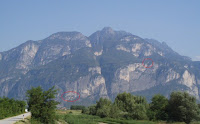.JPG)
As the weather becomes colder and the leaves turn color, signaling a change of seasons, an autumn harvest arrives from the mountains. Streams of smoke rise and the aroma dri
.JPG)
fts through the city, coming from street corners, street vendors' stands and wherever people get together - churches, schools, festivals - the chestnuts have arrived! As a fire burns below, usually in some kind of old steel can or drum, the chestnuts roast atop a perforated lid, husks removed and skin pierced or cut (so they don't explode!). The outside becomes burnt and is usually removed easily to reveal the flesh inside, ready to be consumed. The chestnuts make their way into supermarkets as well, to be taken home to be baked, boiled or roasted.
.JPG)
In Trento, children learn this nursery rhyme, performing during their school's annual festa della castagna:
Filastrocca della castagna
La castagna non si bagna,
quando piove su in montagna
nel suo riccio imbaccuccata,
al riparo se ne stà.
Quando poi fa capolino,
il momento è ormai vicino,
la stagione è cominciata,
in un sacco finirà.
Chissà chissà la castagna dove andrà.
Chissà chissà la castagna dove andrà.
Nella pentola a bollire
e lessata poi uscire
altrimenti zuccherata,
diventar marron glacè:
in una padella apposta
per chiamarsi caldarrosta,
e le mani di un bambino
se fa freddo scalderà.
(And my attempt at a translation!)
Filastrocca della castagna
The chesnuts don't get soaked,
when it rains up in the mountains
wrapped in their curly cloaks,
inside their wrapping they remain.
When they finally peep their heads out,
the moment will soon be here,
the season has just started,
and in a sack will finish up.
Who knows, who knows where the chestnut will end up.
Who knows, who knows where the chestnut will end up.
Put in a pot to boil
left to cook until they come out
and otherwise are sweetened,
to become chestnut glacè:
then they're put inside a fry pan
to become hot fire-roasted,
and the hands of a small child
if they're cold will become toasty.
Links:
Roasted Chestnuts: UncomplicatedItalian festivals: chestnut roasting and nutella at chestnut festival

